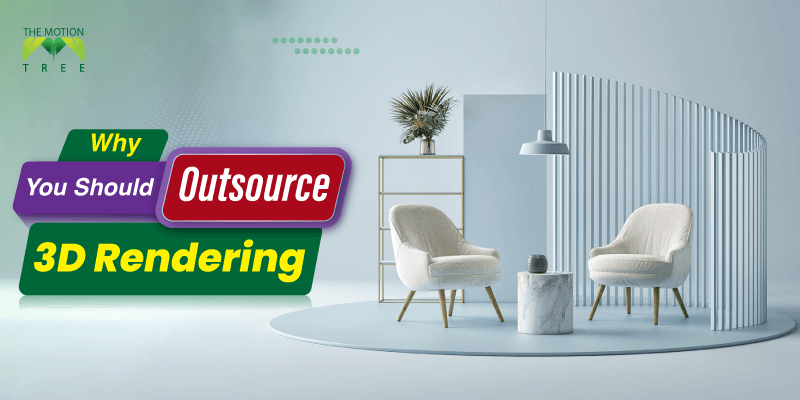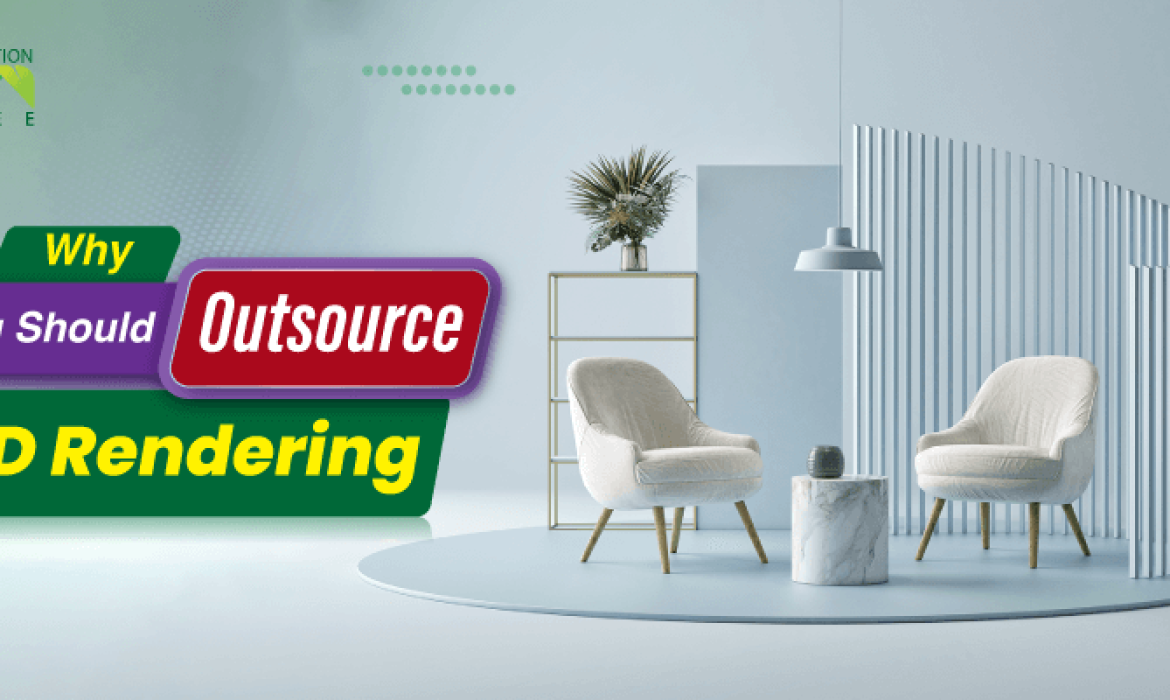![]() +1 929-458-6213
+1 929-458-6213

The demand for 3D rendering is rapidly increasing across industries. Architecture, real estate, and product design businesses rely on lifelike visuals to succeed. Research shows that the global 3D rendering market is expected to grow from $2.5 billion in 2021 to $9 billion by 2030. This growth highlights its importance in delivering high-quality designs and presentations.
Outsourcing 3D rendering can be a game-changer for businesses. It helps cut costs, saves time, and ensures professional-quality results. This blog will inform you about 3D rendering, its challenges, and why outsourcing is the best option. You’ll also discover actionable tips for effective outsourcing.
Table of Contents
ToggleWhat is 3D Rendering?
3D rendering is a process that creates realistic visuals from 3D models. It involves converting computer-generated models into images or animations. These visuals represent objects, buildings, or environments with lifelike detail.
Many industries rely on 3D rendering for various purposes. Architects use it to visualize building designs before construction begins. Real estate businesses use it to create virtual property tours. Product designers use 3D rendering for prototypes and presentations. Entertainment industries use it to create immersive movie and game visuals.
Creating 3D renders involves multiple steps. These include modeling, texturing, lighting, rendering, and post-production. Each step demands specialized tools and skills, making the process time-intensive and complex.
Challenges of 3D Rendering
3D rendering can present several challenges for businesses. Understanding these obstacles is crucial before deciding how to approach them.
It requires costly software and hardware. High-quality rendering tools like Blender or 3ds Max are expensive. Powerful computers are essential for handling complex projects. Statistics show that investing in rendering software and hardware can cost businesses upwards of $10,000 annually.
The process is time-consuming. Rendering a single detailed image or animation can take hours or even days. For large projects, timelines can stretch even longer. For example, architectural firms report that rendering walkthroughs can take up to 50% of their project time.
Creating realistic renders requires specialized skills. Hiring and training skilled professionals can strain budgets. Not every business has the resources to build an in-house team.
Scaling up for large projects is difficult. Managing the workload during peak demand can overwhelm small teams. Businesses often struggle to meet deadlines without sacrificing quality.
Benefits of Outsourcing 3D Rendering

Outsourcing 3D rendering offers multiple benefits. This makes it an attractive option for businesses.
Cost Efficiency
Outsourcing 3D rendering reduces costs significantly. You save money on expensive software, and hardware, and hire full-time specialists. Instead, you pay only for the services you need. This makes budgeting more predictable and manageable. According to a survey, 59% of businesses outsource to reduce costs, and 57% outsource to focus on their core business functions.
Access to Expertise
Professional 3D rendering firms have skilled artists and technicians. They bring years of experience and knowledge to your projects. These experts deliver high-quality results that are hard to achieve in-house. Their work ensures your visuals look professional and polished.
Faster Turnaround Times
Outsourcing speeds up the production process. Experienced teams handle your projects efficiently. Many firms work in different time zones, allowing progress around the clock. Tight deadlines become manageable without compromising quality.
Focus on Core Activities
Outsourcing frees up your in-house team to focus on essential tasks. Your staff can concentrate on strategic planning, client relations, or creative development. This improves productivity and helps grow your business.
Scalability
Outsourcing lets you scale up or down as needed. You can handle large projects during busy seasons without long-term commitments. When demand decreases, you reduce costs by scaling back services.
Why 3D Outsourcing Makes Sense in Today’s Business Landscape
Globalization has made outsourcing 3D rendering more accessible. Businesses can connect with skilled professionals from around the world. This access to talent improves the quality of outputs while keeping costs competitive.
Outsourcing helps businesses stay ahead in competitive industries. High-quality 3D visuals can differentiate your brand and attract clients. Stunning visuals create a strong impression and boost your company’s reputation. A recent report showed that businesses using 3D visuals saw a 40% increase in client engagement.
Technological advancements have also enhanced the outsourcing experience. Many rendering firms use the latest tools and techniques. They deliver cutting-edge results that meet modern standards and expectations.
How to Outsource 3D Rendering Effectively
Outsourcing 3D rendering can be a seamless process if done correctly. Follow these steps to ensure a successful collaboration:
Define Your Needs
Start by identifying your project requirements. Be specific about the scope, goals, and deliverables. For example, you might need architectural walkthroughs or product animations. Clear goals ensure smooth communication with your outsourcing partner.
Choose the Right Partner
Finding the right partner is crucial for success. Research potential outsourcing firms thoroughly. Look for companies with relevant industry expertise. Check portfolios, client reviews, and case studies. A small test project can help evaluate their capabilities before full-scale collaboration.
Set Clear Expectations
Provide detailed instructions about your project. Share design briefs, reference images, or mood boards. Communicate deadlines, budgets, and quality standards upfront. Clear expectations reduce misunderstandings and delays.
Establish Regular Communication
Effective communication is key to successful outsourcing. Maintain consistent communication throughout the project. Use tools like Slack, Trello, or Zoom for updates and feedback. Regular meetings ensure progress stays on track and aligns with your vision.
Review and Provide Feedback
Reviewing outputs carefully helps improve the final results. Provide constructive feedback to refine the results. Open communication helps your partner deliver the best possible outcome. 80% of successful outsourcing projects involve detailed feedback loops.
Challenges of Outsourcing and How to Overcome Them
Outsourcing has challenges, but proper planning can effectively manage these. Below are the common challenges and actionable ways to overcome them:
Finding the Right Fit
Selecting the right outsourcing partner is crucial but time-intensive. With numerous providers in the market, narrowing down the best fit is tough. To address this, conduct thorough research and vet potential partners. Check portfolios, read reviews, and request references from past clients. Starting with a smaller test project can also help assess the quality and compatibility of the vendor before committing to larger tasks.
Ensuring Quality Control
Quality concerns are a significant issue in outsourcing. Misaligned expectations or unclear communication can lead to subpar results. To mitigate this, provide detailed project briefs that outline your requirements, vision, and expectations. Utilize visual references and mood boards to clarify your needs. Review deliverables at every process stage to ensure the work meets your standards.
Navigating Time Zone and Cultural Differences
Working with international teams often involves time zones and cultural barriers. These factors can lead to communication delays and misunderstandings. Overcome this by setting up a clear communication schedule that works for both parties. Tools like Slack or Zoom can facilitate real-time interactions. Cultural training or understanding of local work practices can enhance collaboration.
Managing Deadlines and Revisions
Tight deadlines and multiple revisions can strain the outsourcing relationship. Ensure realistic timelines are set at the beginning of the project. Clear agreements on revision policies, including the number of allowable changes and turnaround times, can help avoid conflicts.
Data Security Concerns
Outsourcing often involves sharing sensitive project data. This can lead to concerns about intellectual property theft or data breaches. Protect your assets by signing non-disclosure agreements (NDAs) with your outsourcing partner. Use secure file-sharing platforms to transfer data. Additionally, work with vendors that have proven security protocols in place.
Cost Overruns
Although outsourcing is cost-effective, unexpected expenses can occur. Hidden fees, additional revisions, or scope changes can inflate costs. Establish a clear, detailed contract outlining all costs upfront to prevent this. Include clauses for managing scope changes to avoid surprises.
Conclusion
Outsourcing 3D rendering offers numerous advantages. It saves costs, improves quality, and enhances scalability. Partnering with experts ensures your visuals meet industry standards and expectations.
Define your needs and choose the right partner to get the best results. Set clear expectations and maintain open communication throughout the project. These steps help create a seamless outsourcing experience.
If you’re looking for a trusted partner, consider The Motion Tree’s 3D rendering services. Our team of experts delivers top-notch visuals tailored to your needs. Contact us today to elevate your projects with professional-grade 3D rendering.
Related Posts






